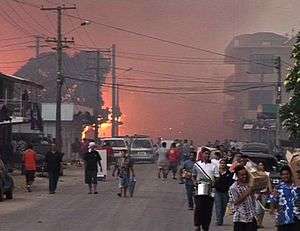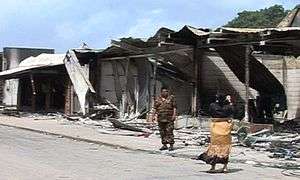2006 Nuku‘alofa riots
| 2006 Nuku'alofa riots | |||||||
|---|---|---|---|---|---|---|---|
 The start of the major fires due to the Nukuʻalofa riots | |||||||
| |||||||
The 2006 Nukuʻalofa riots started on 16 November, in the Tongan capital of Nukuʻalofa. The Legislative Assembly of Tonga was due to adjourn for the year and despite promises of action, had done little to advance democracy in the government. A mixed crowd of democracy advocates took to the streets in protest. Some people in the crowd starting tipping over cars, then progressed to looting and burning buildings.
Targets of riots
Riots broke out around 3:30 pm TOT as rioters threw stones, broke windows, and looted. By about 6:00 pm, rioters started setting buildings on fire. The first targets of the rioters were government buildings. Then they attacked enterprises, including some that were leased to ANZ Bank and those owned by the Prime Minister Feleti Sevele.
A private shop selling mobile telephones and advertising for Tonfön (part of the Shoreline Group of Companies owned, at the time, by the royal family) was next. Rioters also attacked and burned the main office of the Shoreline Group of Companies, which was located one kilometer away from the small central business district.
Several of the larger Chinese shops were targeted for looting and burning. Other shops, including one owned by ethnic Indians, were burned as well, but it is not clear if they were intentionally set on fire or caught fire from surrounding buildings.

At about 6:00 PM TOT rioters torched the Royal Pacific hotel (owned by the Shoreline Group of Companies). The hotel was located on one of the main roads into the city. There are many commercial buildings on the thoroughfare, and the fire spread to some of those buildings as well.
According to an article in Tonga Now,[1] normally law-abiding Tongans of both sexes and all ages were participating avidly in the looting. However, some photos[1] would seem to indicate that the car-tipping and arson were the work of young men. This conception would be reinforced after a destroyed Chinese shop was vandalized with graffiti.
At nightfall, the police and the Tonga Defence Services regained control of the central business district and were turning away anyone who tried to enter.
Aftermath
Estimates of the damage varied. Some estimates said that 60 to 80% of the central business district was destroyed.[2]

17 November
It was announced that eight bodies had been found in charred ruins.[3] Since most of the employees of the affected businesses managed to reach safety, news reports speculated that the dead were likely looters. It is not clear if the deceased have been identified or if identified, when their names will be released.
The Tongan government declared a state of emergency. Only firefighters, police, utility workers, etc. were allowed inside a perimeter defined by Vuna road, ʻAlipate road, Mateialona road, and Tupoulahi road. Residents of that area could enter only after being searched. For the next month, gatherings of more than five persons were illegal in that area. Emergency laws gave security forces the right to stop and search people without a warrant.[4]
The Tongan government promised reform. Popular elections are to be held in 2008, in which a majority of the Legislative Assembly will be elected by a popular vote.[5]
The Chinese embassy chartered an airplane to evacuate Chinese nationals.[6]
18 November
110 soldiers and 44 police officers from Australia and New Zealand arrived to help the local police to establish order. The New Zealand army was to be in charge of airport security and the police were to protect the High Commission. The Australian contingent from the 1st Battalion, Royal Australian Regiment were to assist and relieving exhausted Tongan police.[7]
19 November
A leader of the Tongan pro-democracy movement, MP 'Akilisi Pohiva, has criticised the intervention of Australian and New Zealand peacekeepers following the riots.[8]
20 November
Some businesses had temporarily relocated to the suburbs. Some looted items were returned. Police were guarding the telecommunications center and investigating mobile call logs. According to the Matangi Tonga newspaper, twenty-six arrests had been made and the number of deaths had been revised down to six.[9]
22 November
Nukuʻalofa was by now largely peaceful. The town center was still cordoned off and heavily patrolled, but local shop owners and the like could easily get permission to enter the restricted area. Some Chinese shops which escaped damage were now open again. Major shops and banks, however, were still operating from temporary locations in the suburbs.
1 December
Peace was believed to be restored and foreign forces began leaving. The forbidden area in town was reduced. Police had made 571 arrests.[10]
Maintaining the state of emergency
In late January 2008, the Tongan authorities renewed a Proclamation of Public Order for the sixteenth month running, a lingering aftermath of the riots. The statement reads: "It is hereby proclaimed that there continues to exist a state of danger" in central Nukuʻalofa. According to the Proclamation, the area will remain "controlled and maintained by the Tonga Police Force and Tonga Defence Services for the sole purpose of maintaining public order for all people of the country".[11] Tongan information minister Afualo Matoto announced that the state of emergency would probably be maintained for another three months (i.e., until the end of April). This was criticised by Tongan pro-democracy advocate Akilisi Pohiva: "I don’t see any reason for government to continue to hold on to the emergency power."[12]
The state of emergency was lifted in August 2008. Member of Parliament 'Akilisi Pohiva noted that the government had probably chosen to wait until after the coronation of King George Tupou V to put an end to it.[13] It was, however, re-imposed in September, despite the objections of pro-democracy members of Parliament.[14][15]
Operation Kaliloa
A joint investigation into the riots by the Tonga police, Australian Federal Police and New Zealand Police, codenamed Operation Kaliloa, began.
Tongan MP and former Police Minister Clive Edwards claims that Tongan soldiers have beaten hundreds of people and then refused them treatment for their injuries. Edwards claims he was attacked by soldiers himself.[16] An official of the Tongan Defence Force said there was no evidence to back up Edwards' claims. He would not give his name.[17] On 2 February 2007, Edwards was arrested and charged with two counts of sedition arising from the riots.[18]
The state of emergency declared on 17 November 2006 was extended several times. It was finally ended in January 2011 once the new Prime Minister took office following the 2010 election.[19]
Rebuilding
The first business to rebuild and reopen was the Fung Shin supermarket, which opened in new premises on 19 December 2007.[20]
References
- 1 2 "Riots in Tonga 2006". Planet Tonga. Archived from the original on 14 April 2012. Retrieved 20 November 2006.
- ↑ Fonua, Mary; Linny Folau and Pesi Fonua (16 November 2006). "Rioting crowd leaves trail of wreckage in Nukuʻalofa". Matangi Tonga. Archived from the original on 4 February 2007. Retrieved 20 November 2006.
- ↑ "Riot death toll in Tonga reaches eight". Radio New Zealand. 17 November 2006. Retrieved 20 November 2006.
- ↑ "Tonga passes emergency stop-and-search laws". Radio New Zealand. 17 November 2006. Retrieved 20 November 2006.
- ↑ "Six died in Tonga rioting – report". The New Zealand Herald. 17 November 2006. Retrieved 20 November 2006.
- ↑ "Flight chartered to evacuate Chinese in Tonga". ABC News and Current Affairs. 22 November 2006. Retrieved 26 November 2006.
- ↑ "NZ, Aust troops land in Tonga". Television New Zealand. Australian Associated Press. 18 November 2006. Retrieved 18 November 2006.
- ↑ "Tongan pro-democracy movement slams intervention". ABC News and Current Affairs. 19 November 2006. Retrieved 1 December 2006.
- ↑ "Police confirm six dead in Tonga fires". Matangi Tonga. 22 November 2006. Archived from the original on 27 May 2011. Retrieved 22 November 2006.
- ↑ Radio Tonga news and "Archived copy". Archived from the original on 27 May 2011. Retrieved 2006-12-05.
- ↑ "PM renews public order proclamation for 16th month" Archived 27 May 2011 at the Wayback Machine., Matangi Tonga, 30 January 2008
- ↑ "Tongan pro-democracy advocate questions state of emergency continuation". Radio New Zealand International. 28 January 2008. Retrieved 18 September 2011.
- ↑ "Leading Tongan MP welcomes end of state of emergency". Radio New Zealand International. 29 August 2008. Retrieved 18 September 2011.
- ↑ "Tongan PM re-imposes emergency regulations", ABC Radio Australia, 10 September 2008
- ↑ "Anger in Tonga after emergency police powers put back in place". Radio New Zealand International. 10 September 2008. Retrieved 18 September 2011.
- ↑ "Tonga MP says hundreds brutally beaten by soldiers". Radio New Zealand. 28 November 2006. Retrieved 1 December 2006.
- ↑ "Tongan military dismisses claims of abuse following riots". Radio New Zealand. 29 November 2006. Retrieved 1 December 2006.
- ↑ "Tonga’s former police minister charged with two counts of sedition". Radio New Zealand. 2 February 2007. Retrieved 4 February 2007.
- ↑ U.S. Department of State (31 October 2011). "Background Notes, Tonga". Archived from the original on 13 January 2013. Retrieved 10 February 2013.
- ↑ "Fung Shin opens for Christmas". Matangi Tonga. 20 December 2007. Archived from the original on 24 December 2007. Retrieved 22 December 2007.
External links
| Wikimedia Commons has media related to 2006 Tonga riots. |
| Wikinews has related news: Riots in Tonga |